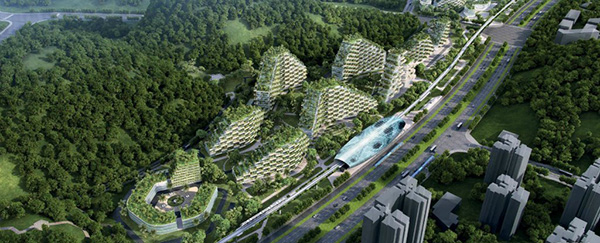
The world’s first ‘Forest City,’ created to fight pollution, is now under construction in Liuzhou, Guangxi Province, China.
Designed by Stefano Boeri Architetti, a team that develops green projects all around the world, the futuristic Forest City will be home to a community of about 30,000 people.
It will be covered in greenery, including nearly 1 million plants of more than 100 species and 40,000 trees that together absorb almost 10,000 tons of carbon dioxide and 57 tons of pollutants, and produce approximately 900 tons of oxygen annually.
As a result, Forest City will help to decrease the average air temperature, improve local air quality, create noise barriers, generate habitats, and improve local biodiversity in the region.
Liuzhou Forest City will be self-sufficient, running on renewable energy sources such as geothermal and solar energy. The project is planned to be complete sometime in 2020.

Thanks, Steve. This makes a good carbon case for leaving these forests on public lands alone: “Reforestation, afforestation, lengthened harvest cycles on private lands, and restricting harvest on public lands increase NECB 56% by 2100, with the latter two actions contributing the most. Resultant cobenefits included water availability and biodiversity, primarily from increased forest area, age, and species diversity. Alterations in forest management can contribute to increasing the land sink and decreasing emissions by keeping carbon in high biomass forests, extending harvest cycles, reforestation, and afforestation. Forests are carbon-ready and do not require new technologies or infrastructure for immediate mitigation of climate change. Growing forests for bioenergy production competes with forest carbon sequestration and does not reduce emissions in the next decades. It also discounts the idea of storing carbon in wood products: “Carbon stored in buildings generally outlives its usefulness or is replaced within decades rather than the centuries possible in forests
Good points. Thanks for contributing. On a side note, I have a good video coming up of a farmer who restored some of the most badly degraded land in Texas and turned it into a paradise. What he did is so simple. He mostly planted grass. The grass helped recharge the aquifer and now it’s full of ponds, streams and wildlife. Coming soon…
I have been drooling over this for YEARS since I heard of the idea even. Was wondering when they were going to get this project going. I am planning a trip to Thailand this year and would love to see this in CHINA and take some pics of the groundbreaking site they are going to build this monster on…super fantastic project!
I love the idea but would like to see more sustainable materials used. It looks like this one is mostly concrete and steel. I’d like to see lower density cities with better materials (a step up from ecovillages).